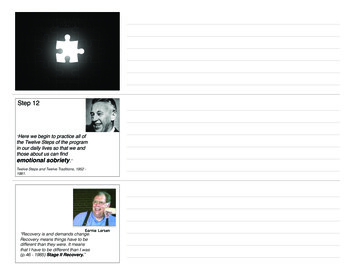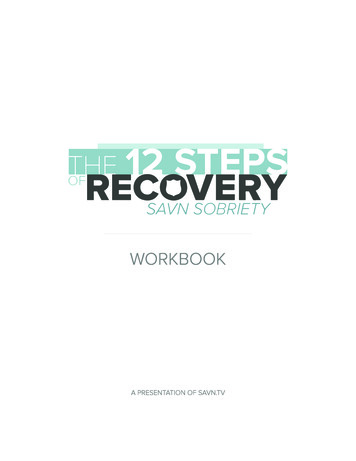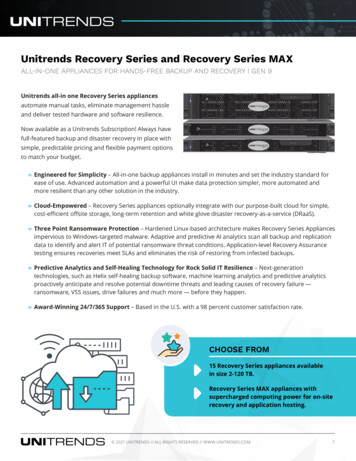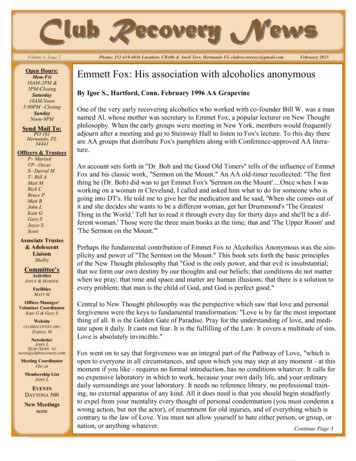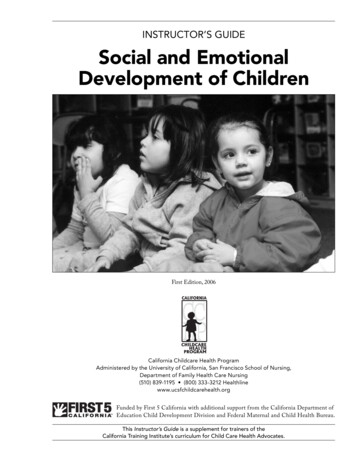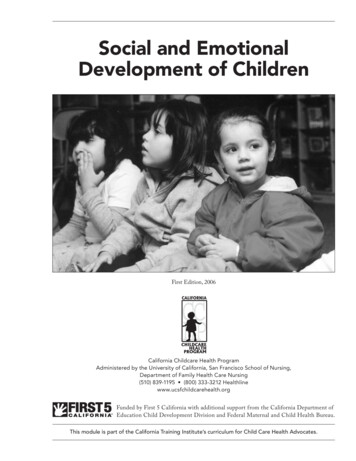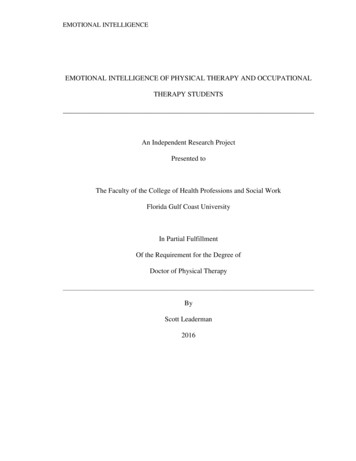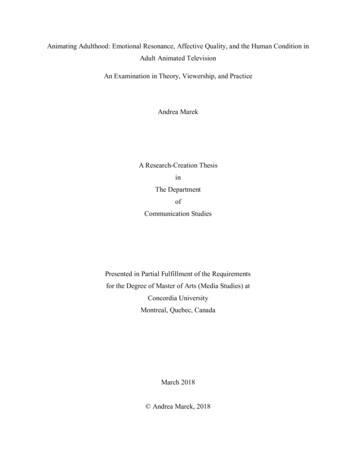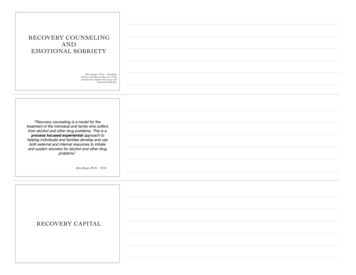
Transcription
RECOVERY COUNSELINGANDEMOTIONAL SOBRIETYAllen Berger, Ph.D. - HazeldenAuthor and Clinical Director of theInstitute for Optimal Recovery andEmotional Sobriety“Recovery counseling is a model for thetreatment of the individual and family who suffersfrom alcohol and other drug problems. This is aprocess focused experiential approach tohelping individuals and families develop and useboth external and internal resources to initiateand sustain recovery for alcohol and other drugproblems.”Allen Berger, Ph.D. - 2018RECOVERY CAPITAL
Robert Granfield and William Cloud (1999)defined the concept of“recovery capital” as:“.the volume of internal and externalassets that can be brought to bear toinitiate and sustain recovery fromalcohol and other drug problems.”External and Internal Recovery CapitalFamily InvolvementMeeting AttendanceProfessional Licensing BoardFellowshipRelationship with SponsorAwarenessOpen MindedFellowshipWillingnessRelationship with the MysteryPsychotherapySelf-SupportHonestyEmotional SobrietyInterventionRelationship with Addict SelfNourishing AttitudesMedical ComplicationsImpending DivorceCommitmentSurrenderPressure from WorkService WorkLegal Trouble“Recovery is defined as thediscovery of newpossibilities.”Allen Berger, Ph.D. - 2018
“This approach optimizes recoverythrough the promotion ofawareness, emotional sobriety,and self-realization.”Allen Berger, Ph.D. - 2018“The ideal therapist-patient relationshipis one which encourages anexistential encounter with theimmediate.”Allen Berger, Ph.D. (2018)Not All Trouble is Created Equally
PRINCIPLES OF RECOVERYCOUNSELINGAddiction issymptomatic ofpsychological andbiological issues butonce expressedbecomes pathogenicitself (primary disease).Recovery progressesthrough severaloverlapping Stages.
Earnie Larsen“Recovery is and demands change.Recovery means things have to bedifferent than they were. It meansthat I have to be different than I was(p.46 - 1985) Stage II Recovery.”Stage I: Freedomfrom addiction(Breaking the bondof addiction).Earnie described Stage OneRecovery as breaking the holdof our primary addiction.Earnie Larsen“Abstinence may get you out of a bad place, but gettingout of a bad place just gets you out; it is not the sameas getting to a good place (p.10).”
Earnie Larsen““Victims of dry drunks have made a First Step relativeto their addiction, but have not made a First Steprelative to the living problems that underlies alladdictions and ultimately limits their ability tofunction in loving relationships.”Emotionalsobriety is thecure for soberFred Holmquist - The Lodge at Hazeldensuffering.Stage II: Personalgrowth and maturity(emotional sobriety learning to havehealthyrelationships).
Earnie described Stage TwoRecovery as “.rebuilding ofthe life that was saved inStage One.”Earnie Larsen“ Stage II Recovery gets at the underlying patternsand habits that caused us trouble in the first place.And if nothing changes, then nothing changes thesame results will pop up through our whole life.”Earnie Larsen“Ibelieve that learning to love (maturelove) and to make relationships work isat the core of full recovery (p. 15).”Stage II Recovery iscontingent on emotionalsobriety.
Stage III: OptimalLivingSelf-Realization:Becoming what wecan be.THE MEANING OFSUFFERING
While the source of ouremotional suffering begins inchildhood experiences, inpractice we operate from thenotion that our emotionalsuffering is sustained andexacerbated by our current wayof functioning.“Where a person experiences a loss ortrauma in childhood that undermineshis sense of security and selfacceptance, he (or she) wouldproject into his (or her) image of thefuture the requirement that it reversethe experiences of the past.”Alexander Lowen, M.D.Lowen, A. (1975). Bionergetics. PenguinBook.Alexander Lowen, M.D.“Desperation createsIllusions - illusionscreate desperation.”
Changing OurPerspective of WhatTrouble MeansTrouble doesn’t meansomething is wrong,quite the contrary, itmeans the something isright about us - it is asignaling process.It is what is right aboutus that we ignore that isat the roots of oursuffering.
We possess a biologicaland psychologicalimperative (growth force)that move us towardsself-actualization(wholeness or integrity).Change is forged in theheat created by discord,suffering, anxiety, griefor pain .THERAPEUTICPERSPECTIVES
The problem is neverthe problem.The problem lies inhow we react to orcope with thetroubling event.Define a patient’s problem in away that creates space betweenthe patient and their problem. Inthat space lies new possibilitiesin coping and growing.
The proper digestion ofpersonal experiences isthe key to growth andrecovery - bringing newawareness and newpossibilities.We focus our attentionon process more thancontent.We listen to whatthe patient isunable to say (thishelps us identifythe working point).
The working pointrepresents theunrealized next orwhat is missing.THERAPEUTICTECHNIQUES“Therapy at its greatestmoments provides masterfulexamples of a sequentialimperative, the sense of theirresistible sweep intonextness. Experienceappears to be seamlesslyand inevitablyinterconnected, forming asequential fit.”E. Polster, Ph.D. (1995).
“Provide yourclients with asmuch support asnecessary, andas little aspossible.”Laura Perls, Ph.D.SuppressiveInterventionsGoal: Interruptavoidancestrategies.
g andqualifiers likemaybe or possibly.Promote anawareness ofshoulds andexperiment withthe opposite.
Challengeevaluations andjudgments.ExpressiveInterventionsGoal: Authenticity to encourage aperson to be fullywho and what he orshe is in themoment.
Initiating action maximizing initiative, risktaking, and overtexpression in action andlanguage.Completing emotionalexpressions - recognizingblocked emotions andencouraging theirexpression.Expressive InterventionsSimple RepetitionExaggerate what is or isn’t.Identifying conflict and enacting it(chair work).Pointing out incongruence betweenwhat is said and how it is said orbetween verbal and non-verbal.Encouraging directness.
IntegrativeInterventionsGoal: To facilitatepersonality integrationbetween disharmoniousparts of the self and toreorganize the self partsinto a more coordinatedand healthy functioningwhole.Assimilation projections- reformulating theprojected experience as one’sown.
Addressing PathologicalIntrojectionsRejecting the IntrojectDigesting the Introject
Chair work is avery usefulintervention topromoteintegration.CHAIR WORK INRECOVERY COUNSELINGChair Work in Recovery Counseling
Fritz Perls, M.D.Co-founder of GestaltTherapy introduced chairwork into therapy. His workwas influenced by manyprominent therapists of thetimes.CLINICAL INFLUENCES ONGESTALT THERAPYChair Work: Fritz’s ProfessionalInfluencesUnlike Sigmund Freud, SandorFernczi advocated a more active rolefor the analyst. He believed the“empathic response” was the basisof clinical work and focused hisattention on the subjectiveexperience of the patient. Heviewed the analyst as a “coparticipant" in the therapeuticencounter. He also experimentedwith having his patients enactsituations in the office that they werehaving difficulty with in their lives.Sandor Ferenczi, M.D.
Chair Work: Fritz’s ProfessionalInfluencesFritz’s developmental concepts seem tohave been influenced by Karen Horney’stheoretical orientation. She opined thatwe all suffered from a basic anxietywhich propelled us on a search to resolvethese feelings. This search ended withestablishing a “false-self” to resolve ourworse fears - that we wouldn’t be loved,accepted or belong. This means wefragmented ourselves to find a solutionfor our anxiety. Awareness of how thiswas influencing a patient’s currentfunctioning was critical to the therapeuticprocess.Karen Horney, M.D.Chair Work: Fritz’s ProfessionalInfluencesWilhelm Reich originated bodywork. He believed we armoredourselves against the experience ofpainful emotions. This was calledmuscular or body armor.His therapy was focused onaddressing the resistance tothe experience of painfulemotions. Resistance needed tobe addressed first before changecould occur. This was called“characterological rigidity.”Wilhelm Reich, M.D.Chair Work: Fritz’s ProfessionalInfluencesMoreno recalled an encounter with SigmundFreud in 1912. "I attended one of Freud’s lectures.He had just finished an analysis of a telepathic dream.As the students filed out, he singled me out from thecrowd and asked me what I was doing. I responded,'Well, Dr. Freud, I start where you leaveoff. You meet people in the artificialsetting of your office. I meet them on thestreet and in their homes, in their naturalsurroundings. You analyze their dreams. Igive them the courage to dream again. Youanalyze and tear them apart. I let themact out their conflicting roles and helpthem to put the parts back togetheragain.'"Jacob L. Moreno, M.D.
Chair Work: Fritz’s ProfessionalInfluencesDr. Moreno’s psychodramaprovided “ an opportunity to getinto action instead of just talking, totake the role of the importantpeople in our lives tounderstand them better, toconfront them imaginativelyin the safety of the therapeutictheater, and most of all to becomemore creative andspontaneous human beings.”Jacob L. Moreno, M.D.Similarities and Differences betweenPsychodrama and Chair WorkPsychodramaChair WorkMovement from talking about toenactment.Movement from talking about toenactment.Confront issues in the safety of thetheatre (psychodrama).Creates a safe emergency inconfronting issues.Promotes Empathy towards selfand others.Promotes Empathy towards selfand others.Promotes spontaneity, creativityand experimentation.Promotes spontaneity, creativity,and experimentation.Therapist is an active participantTherapist is an active participantguiding, designing and creating an guiding, designing and creating anexperiment.experiment.Audience participation in rolePatient plays all roles.playing.Summary of Clinical Implications Therapist focuses on understanding and exploring the subjective experience ofthe patient in the here and now. Process is more important than content. Therapist moves quickly from talking aboutism to enacting and experimenting. Experimentation is used to increase a patient’s awareness, increase creativeproblem solving abilities, and spontaneity. Pay attention to the patient’s body and other non-verbal information. Therapy concerns resolving intrapsychic and interpersonal conflict. Therapist stays in close contact with the patient. Therapist identifies the working point and designs interventions appropriately.
THERAPEUTIC EFFECT OFCHAIR WORK“When there is apsychologicaldisturbance these selvesare alienated from eachother, leading tofragmented living.”E. Polster, Ph.D. (1995).Dr. Fritz Perls (1969)defined mental health as “anappropriate balance of thecoordination of all of whatwe are.”
Dr. Erving Polster indicated thatthe goal of psychotherapy is“.to merge the disharmoniousaspects of the person so thatthey [can] become jointcontributors to the person’swholeness.”This means that helpinga client integrate theirdifferent self-parts into aunified whole is criticalto establishing stableand longterm recovery.CHAIR WORK PROTOCOL
Protocol for Setting Up Chair Work1. Lay the ground work for chairwork - explain the purpose of thisexercise.2. Describe the experiment andstarting point.3. Negotiate consensus.4. Enact the experiment.5. Identify the working point byfocusing on process.6. Focus awareness on what ishappening.7. Identify what is missing in thedialogue, suppress avoidance, andencourage expression.8. Experiment with new possibilities.9. Integrate the ones that work.10. Debrief and closure.APPLICATIONS OF CHAIRWORKSelf-Part Conflict
Interpersonal Conflict
Addict Self - Recovery Self DialogueCharacteristics of Addict Self - Recovery SelfAddict SelfRecovery SelfManipulative, Dishonest,Deceptive, Calculating, andDisingenuousHonest, Transparent, Genuine,and AuthenticUnaware, Numb and DeadAware, Alive, Curious,Passionate, and ResponsiveClosed, Deliberate, andControllingOpen, Free, and SpontaneousDisrespect for Self and OthersRespect for Self and OthersDistrust and CynicismTrust, Faith and BeliefToxicNurturingThe Shuttle Technique: In Early Recovery
The Shuttle Technique: After 3 Weeks in TXAA is Like Being Back in High School
Four Variations of the Addict Self Recovery Self Dialogue Shuttle: Addict Self - Recovery Self. Shuttle: Addict Self - Recovery Self Protective Self Shuttle: Addict Self - Recovery Self Higher orWise SelfNote: All variationsthis experimentcan beSelfovert or covert, Voice Dialogue:AddictofSelf- Recoveryenacted or imagined.Resolving Trauma or OtherUnfinished BusinessValue of ExperientialInterventions
Promotes awareness of who oneis and even more importantlywho one isn’t.“ experiments areused to expand therange of the individualshowing him how hecan extend his habitualsense of boundary ”E. & M. Polster, Ph.D. (1973).Gestalt Therapy Integrated.If done right, an exercise orexperiment stimulates aninterest in oneself and facilitatesthe discovery of newpossibilities.
We encourage you tofollow the golden thread.Reveals patterns or themes infunctioning.Identifying the working pointprovides directionality and acontext to the experiment.
Facilitates awareness throughimmediate feedback andsomatic experiencing.Facilitates learning that isintegrated both intellectuallyand emotionally.Helps a client loosen up anddevelop flexibility andspontaneity.
Encourages experimentationand creativity in recovery.Grade exercises orexperiments up ordown depending onthe individual’s orgroup’s level offunctioning.Grading down means todecrease the level of difficulty.
Grading up means to increasethe level of difficulty.Contact InformationAllen Berger, Ph.D.2200 Pacific Coast Highway, Suite 219Hermosa Beach, CA 90254818-584-4795E-mail: abphd@msn.comWebsite: www.abphd.com
Allen Berger, Ph.D. - Hazelden Author and Clinical Director of the Institute for Optimal Recovery and Emotional Sobriety Allen Berger, Ph.D. - 2018 “Recovery counseling is a model for the treatment of the individual and family who suffers from alcohol and other drug pro
